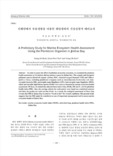

PARTNER
검증된 파트너 제휴사 자료
진해만에서 부유생물을 이용한 해양생태계 건강성평가 예비조사 (A Prelimiary Study for Marine Ecosystem Health Assessment Using the Planktonic Organism in Jinhae Bay)
8 페이지
최초등록일 2025.03.19
최종저작일
2010.09

-
서지정보
· 발행기관 : 한국환경생물학회
· 수록지 정보 : 환경생물 / 28권 / 3호 / 125 ~ 132페이지
· 저자명 : 백승호, 최현우, 김영옥
초록
하계 진해만 16개의 정점에서 해양생태계의 오염 정도를 평가하기 위해서 플랑크톤 건강 지수를 살펴보았다. 해양생태계 건강지수 산출은 부유성 플랑크톤 생물엔테로박테리아 Escherichia coli, HB, ANF, HNF, HABs 그리고 섬모충류 등과 더불어 무기와 유기 오염원인DOC, COD, 그리고 Chl.a 등을 각각 조사하였다. 그 중플랑크톤 지수 산출은 오염압력의 반응에 민감한 Chl.a,HABs, HB, E. coli 등 4개의 지표를 시범적 선정하였다.
또한 점수산정기준은 과거자료를 바탕으로 통계학적 기법으로 해석하였으며, 그들 건강지수 등급도 4개로 나누었다. 그 결과 진해만 해역은 전반적으로 “좋음”의 B등급을 받았다. 본 연구에서 산출한 플랑크톤 건강지수는진해만의 해양생태계 건강성 평가를 하기 위한 좋은 방법 중 하나로 고려하여도 될 것이다.영어초록
In order to assess the effect of pollution on marine ecosystem, we examined the plankton health assessment at 16 stations during summer season in Jinhae Bay. The organic and inorganic pollutant sources (dissolved organic carbon; DOC, chemical oxygen demand; COD and Chlorophyll a; Chl.a), including planktonic orangism such as enterobacteria Escherichia coli, heterotrophic bacteria (HB), autotrophic nano-flagellates (ANF), heterotrophic nano flagellates (HNF),ciliate and harmful algal bloom species (HABs) were used to characterize marine ecosystem health assessment. Of these, we tentatively selected those items Chl.a, HABs, HB and E. coli for plankton health index (PHI). Also, the scoring criteria for each metric were based on a statistical analysis and then, the grades are rated on four levels. As a result, the ecological assessment of these data reveals that PHI in Jinhae Bay is rated as “Good or fair” for overall conditions. The present study suggests that the PHI might be considered as one of important management tool to assess marine ecosystem health of Jinhae Bay.참고자료
· 없음태그
-
자주묻는질문의 답변을 확인해 주세요

꼭 알아주세요
-
자료의 정보 및 내용의 진실성에 대하여 해피캠퍼스는 보증하지 않으며, 해당 정보 및 게시물 저작권과 기타 법적 책임은 자료 등록자에게 있습니다.
자료 및 게시물 내용의 불법적 이용, 무단 전재∙배포는 금지되어 있습니다.
저작권침해, 명예훼손 등 분쟁 요소 발견 시 고객센터의 저작권침해 신고센터를 이용해 주시기 바랍니다. -
해피캠퍼스는 구매자와 판매자 모두가 만족하는 서비스가 되도록 노력하고 있으며, 아래의 4가지 자료환불 조건을 꼭 확인해주시기 바랍니다.
파일오류 중복자료 저작권 없음 설명과 실제 내용 불일치 파일의 다운로드가 제대로 되지 않거나 파일형식에 맞는 프로그램으로 정상 작동하지 않는 경우 다른 자료와 70% 이상 내용이 일치하는 경우 (중복임을 확인할 수 있는 근거 필요함) 인터넷의 다른 사이트, 연구기관, 학교, 서적 등의 자료를 도용한 경우 자료의 설명과 실제 자료의 내용이 일치하지 않는 경우
“환경생물”의 다른 논문도 확인해 보세요!
-
낙동강 하류부에서 Stephanodiscus속에 의한 수화 발생시 미생물먹이망 군집 동태 7 페이지
조사지점인 구포에서 발생한 규조류인 Stephanodiscus 속에 의한 수화현상은 본 연구 시점인 1월부터 관찰되었으며 4월 18일을 기점으로 감소하기 시작한 것으로나타났다. 박테리아 군집은 규조류 대증식 현상이 소멸한 이후 증가하는 양상을 나타내었다. 이것은 규조류 수화현상이 종결되면서 조류에 의한 분비물 및 세포 분해산물(cell lysis)이 수중에.. -
태화강의 어류군집에 대한 병원체 모니터링 7 페이지
2007년 3월부터 2009년 1월까지 울산 태화강에 서식하는 어류의 군집 구조 및 병원체에 대하여 조사하였다. 그 결과 태화강의 3개 조사지점으로부터 채집된 어류는모두 총 9목 17과 35종이었으며 개체수로서의 우점종은끄리로서 39%였으며 다음으로 누치가 30.9%였다. 한국고유종은 전체의 20.8%로서 참몰개, 참갈겨니, 기름종개,꺽지, 동사리의 5종이..
찾으시던 자료가 아닌가요?
지금 보는 자료와 연관되어 있어요!
문서 초안을 생성해주는 EasyAI


